Back in the day, guys like Arnie and Ronnie Coleman trained differently to how most people train now. Old-school bodybuilding is all about free weights, supersets, and hitting muscles from every possible angle.
That means these guys knew a huge range of exercises so they could target every part of their body. Some of those exercises have become “old-fashioned” or “obscure” in today’s gyms… Like the dumbbell pullover.
Today we’re dedicating an entire article to it because it’s such a great movement to add to your repertoire. It’s definitely an old-school bodybuilding exercise, and some people consider it to be unsafe today. But if you take the time to learn the proper form and start to feel it in the right place, you’ll begin to see why it’s such a great exercise to do.
Jump to:
- What Muscles Does the Dumbbell Pullover Work?
- Dumbbell Pullover vs. Bench Press: What’s the Difference?
- Benefits of Dumbbell Pullovers
- How to Do Dumbbell Pullovers Correctly
- Tips to Get Your Dumbbell Pullover Form Right
- Common Dumbbell Pullover Mistakes To Avoid
- Dumbbell Pullover Variations
- Who Shouldn’t Do This Exercise?
- Alternative Exercises
What Muscles Does the Dumbbell Pullover Work?
The dumbbell pullover is a bit of an anomaly, because it works two major muscle groups at the same time. Both the chest and the lats are involved in this movement, and they’re the primary muscles that get worked.
Your shoulders, triceps, and core are also slightly involved, so it’s quite a well-rounded upper body exercise… As long as you’re keeping your form! If you do it right, it’s also a fairly ab-intensive exercise.
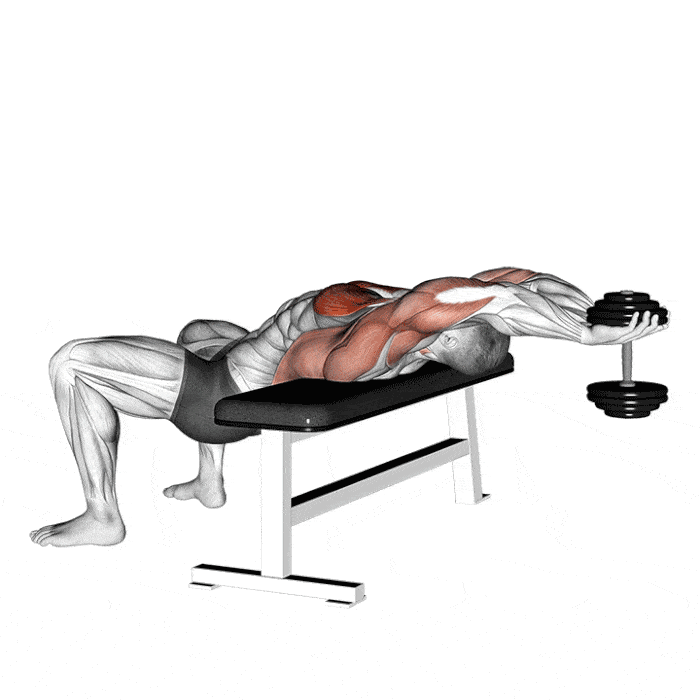
Dumbbell Pullover vs. Bench Press: What’s the Difference?
The most obvious difference is in the muscles worked. The flat bench press works mainly chest and triceps as a secondary muscle. Dumbbell pullovers work chest, triceps, lats, and shoulders.
The movement is also quite different. The bench press is a vertical movement from the chest (where the arms are bent) upwards, until the arms are fully extended. Dumbbell pullovers keep the arms straight, moving the weight from above the body to behind the head without bending the arms at all.
Both are great exercises that should be included in your weekly routine, but it’s important to understand that there’s quite a difference between the two.
Benefits of Dumbbell Pullovers
Dumbbell pullovers offer plenty of benefits that you don’t always find with alternative exercises. Here are just a few reasons you should be adding this movement into your exercise routine!
May Improve Shoulder Flexibility
The overhead movement of the dumbbell pullover exercise trains the shoulder’s extensor muscles. But it does so specifically in the stretched position, which encourages increased mobility.
It’s important to note that shoulder mobility increases over time when performing this exercise. You’ll need to be consistent with your dumbbell pullovers to reap this benefit! It’s also essential to choose a manageable weight, as going too heavy can have the opposite effect and cause damage to the shoulder ligaments.
Hypertrophy – Faster Muscle Growth
The greatest muscle growth happens under mechanical tension, which is the force applied to the muscles when you lift heavy weight. There are two parts to this process: muscular contraction and the stretched position at the end of the range of motion.
Time under tension is an important factor for driving muscle growth. Which means if you’re cutting your reps short without moving through the full range of motion, you’re missing out on muscle gains! Extending the movement as fully as possible is where hypertrophy really begins, because to lift weight from a stretched position requires the muscle to work harder.
When it comes to the dumbbell pullover, both the chest muscles and the lat muscles are in a stretched position when the weight is lowered behind your head. Contracting your muscles from that position to bring the weight up again gives you excellent hypertrophy gains.
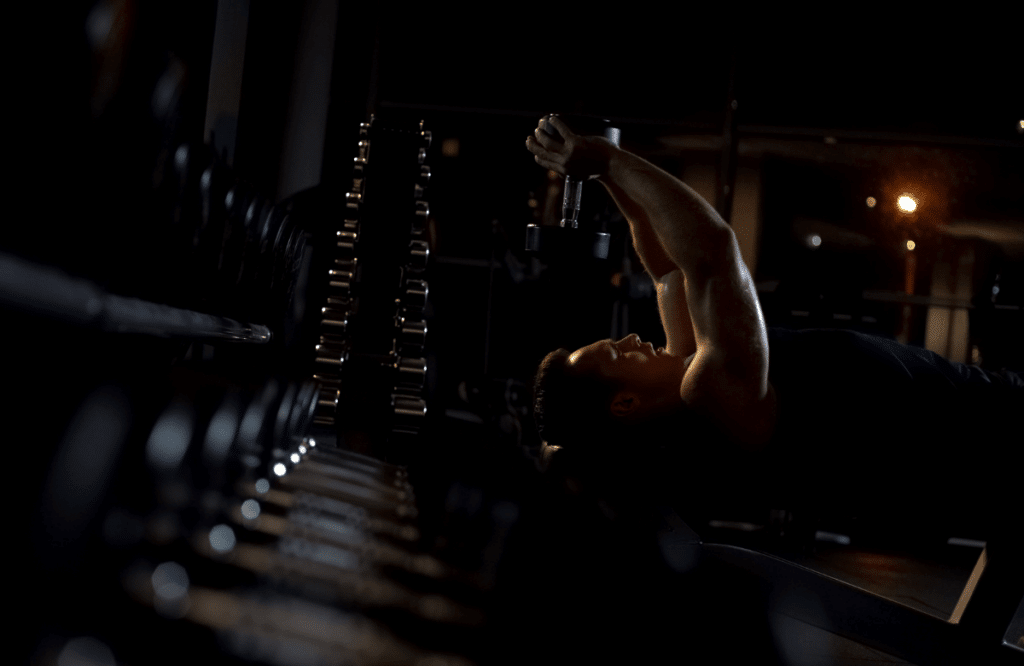
Improves Core Stability & Strength
In order to stabilize yourself properly on the bench, it’s essential to engage your core. It doesn’t matter how exactly you’re resting on the bench (more on that later)—you’ll be at risk of injury if you don’t tighten your abs while you’re doing this movement.
That means for every pullover you do, you’re also getting a pretty decent core workout. It may not target your core specifically, but the constant time under tension in this exercise will strengthen the core muscles.
This will also serve you well for other exercises. Pretty much all the big lifts involve the core, so the more you can strengthen it, the better all your lifts will become.
Strengthens the Mind/Muscle Connection
While all exercises strengthen the mind/muscle connection if you do it right, the dumbbell pullover offers a unique opportunity to really connect the two. Depending on exactly how you do it, you could end up targeting the chest or the lats more specifically, so it’s a good chance to really work on feeling where it’s working.
Engaging that mind/muscle connection can come in handy for placing more emphasis on the muscle you want to target. It takes some practice, but if you get this right, you can start to really focus in on your muscles in all exercises and reap the muscular benefits.
Engages Muscles from a Different Angle
The dumbbell pullover works the chest and lats quite differently to any other exercises. You don’t need to give up your big lifts like bench press and lat pulldowns, but adding DB pullovers to our routine really helps you to hit those muscles from all angles, boosting hypertrophy.
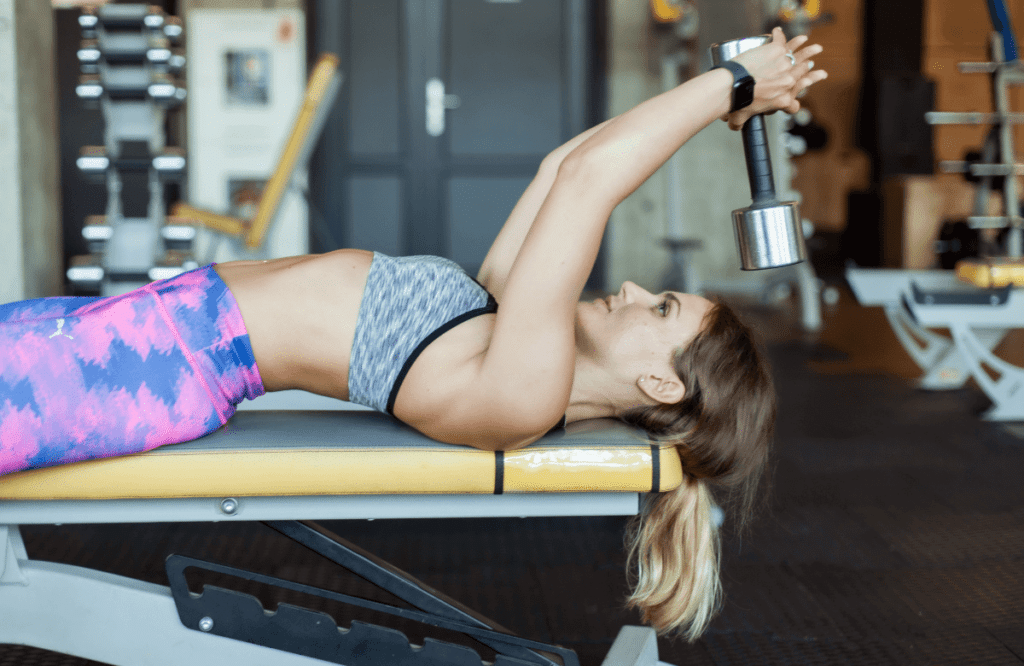
How to Do Dumbbell Pullovers Correctly
Doing dumbbell pullovers the wrong way can increase your risk of injury and have minimal effects on your muscle growth. But do it right (and consistently), and you can expect to see excellent results. Here’s how to get it right.
Choose the Correct Dumbbell Weight
This is very important. Get it wrong, and you’re not only risking injury, but you’ll miss out on all the muscular benefits of the movement. Start with a weight that’s less than you think you can actually lift in this position.
From there, you can adjust. The optimal rep range for men is 4 to 6, and for women is 8 to 10. If you can’t yet hit the minimum (4 or 8 reps) with the weight while keeping perfect form, then you’re lifting too heavy.
On the other hand, if you can hit the top end of the range (6 for men, 10 for women), then it’s a sign that you can increase the weight. It’s extremely important that you do each rep with proper form—if you’re hitting your minimum reps but half of them are with sloppy form, they don’t count.
Set-Up Position
There are multiple ways to do this exercise, but they all include a bench. Some will have you lying on the bench in the same position as if you were to do a bench press. If you prefer to do it this way, make sure your head and neck are supported.
But the better way is to position yourself at a 90-degree angle to the bench, with your shoulder blades resting on the bench. This position is also known as the perpendicular bench pullover or the cross-bench pullover.
This will require you to tense your glutes and lift yourself off the floor so your back and thighs are parallel to the ground. Here’s where you need to tighten your core so you can hold yourself in this position throughout the movement.
If you can get yourself into this position first and get someone to pass you the dumbbell, that’s first prize. But that’s not practical for everyone, so we recommend settling yourself into a squatting position on the floor with your back to the bench, picking the dumbbell up from there and holding it in front of your chest as you lean your shoulders back onto the bench.
From there, you can wiggle your shoulders up onto the bench in the proper position as you tighten your glutes and lift your hips. We suggest letting your head hang back over the edge of the bench to avoid straining your neck muscles.
Once you’re in the position, bring your arms up above you with the weight. Once the weight is above you with your arms fully extended, you’re in the right starting position.

Lower to the Back
Make sure to engage your core and keep your glutes tight. Inhale and lower the weight behind you, keeping your arms straight. You don’t need to lower it too far—in line with your head is good for working your chest, a little lower if you’re targeting the lats.
It’s essential to keep your core tight at this point, so you don’t end up dropping your butt and arching your back.
Raise the Dumbbell and Repeat
The way you bring it back up will vary slightly depending on the muscle you’re targeting. If you want to really work the chest muscles, contract your chest muscles and push your hands together as you bring the weight up again. Try to visualize your shoulders rotating inwards as you do this.
If you want to target the lats more, try to flex them as you bring the weight up, but try not to push your hands together. Rather, imagine keeping your hands and arms coming back up in exactly the same line they went down.
Tips to Get Your Dumbbell Pullover Form Right
Follow the steps above to make sure you’re doing the DB pullover the right way. Here are some important things to remember while you’re doing the movement to keep your form.
- Keep your core tight
- Keep your glutes up
- Try not to arch your back
- Don’t go down lower than necessary
- Don’t rush the movement
- Stop if you feel pain
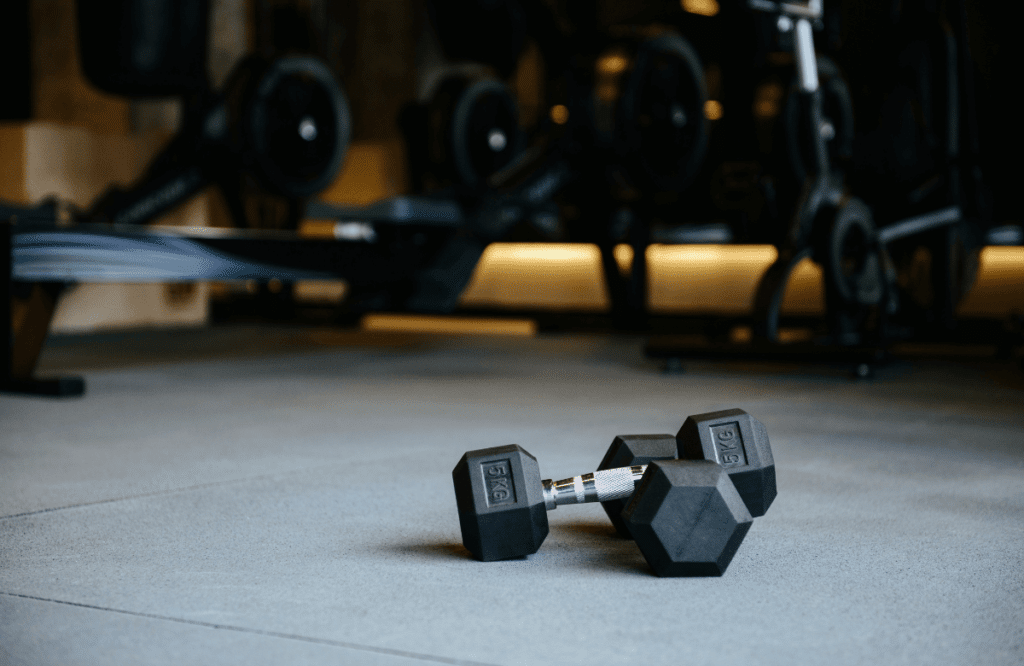
Common Dumbbell Pullover Mistakes To Avoid
Keep these common mistakes in mind to make sure you’re never putting yourself at risk of injury.
Dropping Your Glutes
You may see videos of lifters performing the dumbbell pullover with their lower body in a close-to-squat position. While this does increase the stretch in the muscles, it also places more stress on the lower back, so we don’t advise it.
Not only does keeping your glutes up help you to avoid back pain during and after this movement, but it also gives you more opportunity for building muscle and strength. By keeping your glutes tight during this movement, you’ll be getting a bit of a glute workout as well.
Forgetting to Engage Your Core
Tightening your core during this movement helps to keep your posture right, avoid unnatural movement that could lead to injury, and helps you to maximize the stretch in the pecs and lats.
You can hold yourself up using your glutes alone, but it’s going to have much less effect. You’re likely to fatigue your glutes too quickly, so pairing glutes and core is the best way to stabilize yourself.
Holding the Dumbbell Too Tightly
You don’t need to grip the dumbbell hard. It’s tempting to hold the dumbbell tightly and stop it from “hanging” as you go down. But this just activates the wrist flexors unnecessarily, and can cause pain, a limited range of motion, and accelerated fatigue.
The dumbbell should hang from your hands as you bring it down. It should almost be resting on your hands, rather than you actually holding it. If the dumbbell is tilting during the movement, you’re holding it too tightly.
Doing the Movement Too Fast
Letting momentum take over will reduce muscle activation and increase your chance of injuring yourself. Make sure you’re moving through the motion slowly—it should be taking you 3 to 4 seconds to lower the weight, and 2 seconds or so to bring it back up.
This is an exercise where you definitely shouldn’t be just “going through the motions”. You need to do it slowly, focus on the muscle you want to activate, and keep your form perfect. Take your time with dumbbell pullovers—you’ll thank yourself later!

Using a Weight That’s Too Heavy
This is probably the easiest mistake to make, other than getting your form wrong. We strongly advise starting with a lighter weight than you think you need, because going too heavy can have disastrous consequences.
Firstly, you don’t want to be holding a heavy weight above your face if you don’t have perfect control of it! Secondly, if the weight is too heavy, you’re going to struggle to lift it from the extended position without losing your form.
Bringing heavy weight back up might cause you to arch your back or drop your glutes in an attempt to gain some leverage. You won’t be getting the full muscle-working effect of the movement in that case, and you’ll be more susceptible to injury.
Or worse, the weight could cause you to extend too far back, wrenching your shoulder joints as they move out of a normal range of motion. This kind of injury can have long-lasting consequences and may even need surgery.
Bending/Flaring Your Elbows
This movement should be done with your arms as straight as possible. You don’t need to lock your elbows out, but do your best not to bend or flare your elbows when doing it.
Bending your elbows brings the dumbbell closer to the shoulders and reduces the muscular activation of the chest and lats. In this case, you may end up doing something closer to skull crushers, which will nail your triceps but have less effect on other muscles.
If you do end up bending your elbows, there’s also a high chance of them “flaring” outwards on this movement. This can be dangerous because it causes an internal rotation of the shoulder joint, which can place the ligament under strain during the exercise.
Dumbbell Pullover Variations
If you don’t feel comfortable doing the dumbbell pullover with one dumbbell, there are a few different variations you can try. Find the one that feels best to you and gets that muscle activation. As long as you do it with good form and you stay consistent, you can expect to gain the benefits.
Two-Dumbbell Pullover
You can do this move with two dumbbells instead of one. You’ll hold them together, with a neutral grip, like you’re about to perform dumbbell flys. Everything else remains the same—your position on the bench, your tight glutes and core, and so on.
Lower them behind your head the same way you would a single dumbbell. Try not to tilt your wrists during this movement, or you could injure yourself.
You can further split this into single-arm pullovers if you want to. However, you need to be extra careful with these, as the potential for losing your form is greater. Because you’re placing weight on only one side of your body, you’ll be less stable.
It’s essential that you keep both your shoulders firmly on the bench and make sure your torso doesn’t rotate as you lower and lift the weight. You may want to drop the weight to around 50 to 60% of what you’d use with a single dumbbell.

Barbell Pullover
Hand placement is important when using a barbell. If you want to target the chest, aim for a closer grip. Make sure you’re using a weight that you can easily control, as having both your hands close to the middle of the barbell can result in some instability and balance issues.
To target the lats, a shoulder-width, overhand grip will work well. Remember not to bend your elbows. Also don’t forget that the barbell’s weight is distributed differently to a dumbbell, so expect this to feel different and take some time to get used to.
With Stability Ball
Instead of a bench, you can use a stability ball to support your shoulders. But be aware that it will require a lot more stabilizing, which means your core and glutes need to be strong if you want to do this variation safely.
You can get a little bit of a deeper stretch thanks to an extended range of motion on the ball. But it’s a lot less stable than a bench so it may be a good idea to lower the weight you’re lifting.
This is a good variation to try when you’ve built up some decent strength on the movement and you want a bit more challenge. It may not be a good one for beginners—if you’re new to it and don’t have a bench, we’d suggest doing it lying flat on the floor instead.
Parallel Bench Pullover
If you aren’t comfortable with the cross-bench position, try this variation. You’ll lie on the bench like you’re going to do a normal bench press. That’s the only thing that’s different—instead of lying perpendicular to the bench with only your shoulders on it, you’ll just lie on it like normal.
While you still need to engage your core to have optimal form, this version significantly reduces glute activation. If you want more of a challenge for your pectoral muscles, try it on a decline bench.
This is also a good choice for those who have difficulty finding a comfortable neck position with the cross-bench variation.
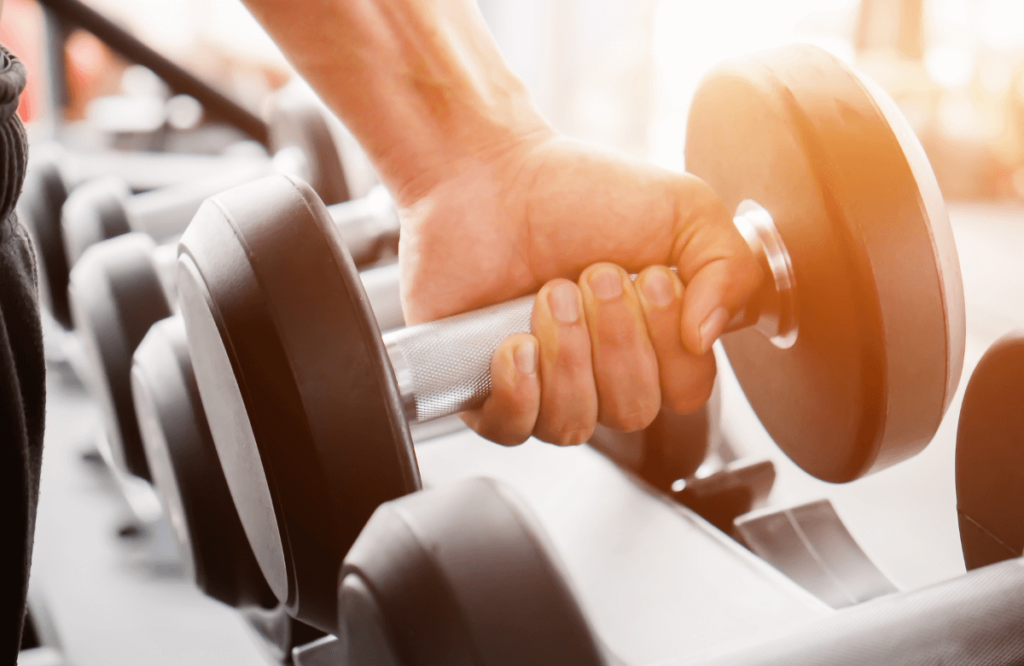
Who Shouldn’t Do This Exercise?
If you’ve had a shoulder injury and your mobility is compromised, it’s a good idea to focus on other exercises to build up shoulder stability and strength and improve your mobility before trying the dumbbell pullover.
If you’re a novice lifter, you might also want to build up some strength before trying these. You’ll be holding weight directly over your face, so if you aren’t comfortable with that, it’s probably best to avoid this particular movement.
Alternative Exercises
Got shoulder issues or worried about doing the dumbbell pullover movement? Here are some alternative exercises that you might feel more comfortable with. While they don’t get quite the same level of muscle activation as the dumbbell pullover does, they’re better suited to certain people and still give you an excellent muscular workout.
- Cable chest dip
- Lying cable pullover
- Cable crossover
- Straight-arm cable pushdown
- Decline chest fly
- Pull-ups















